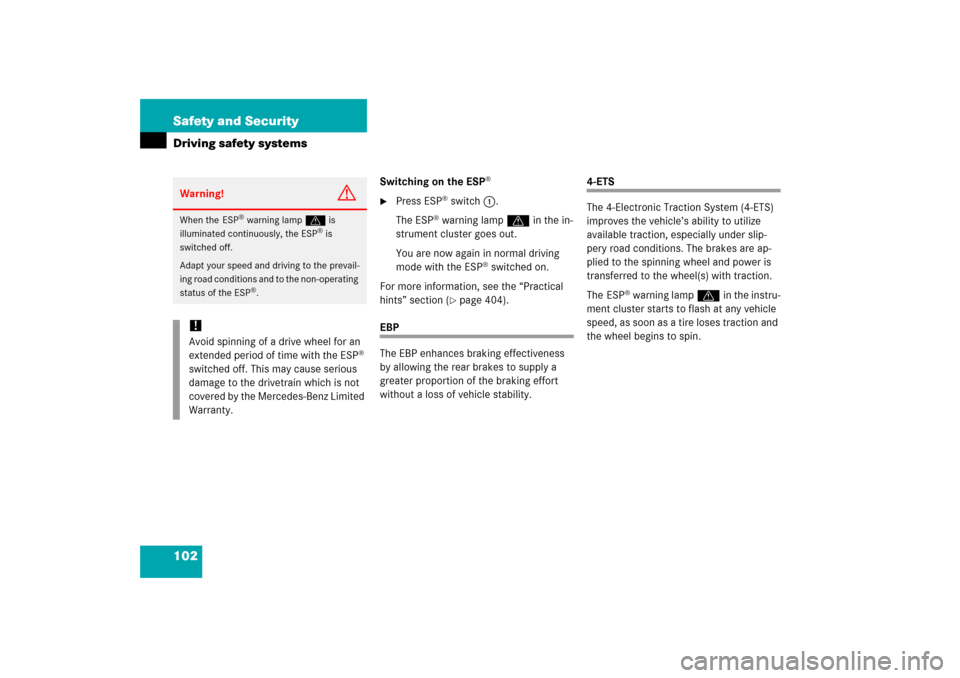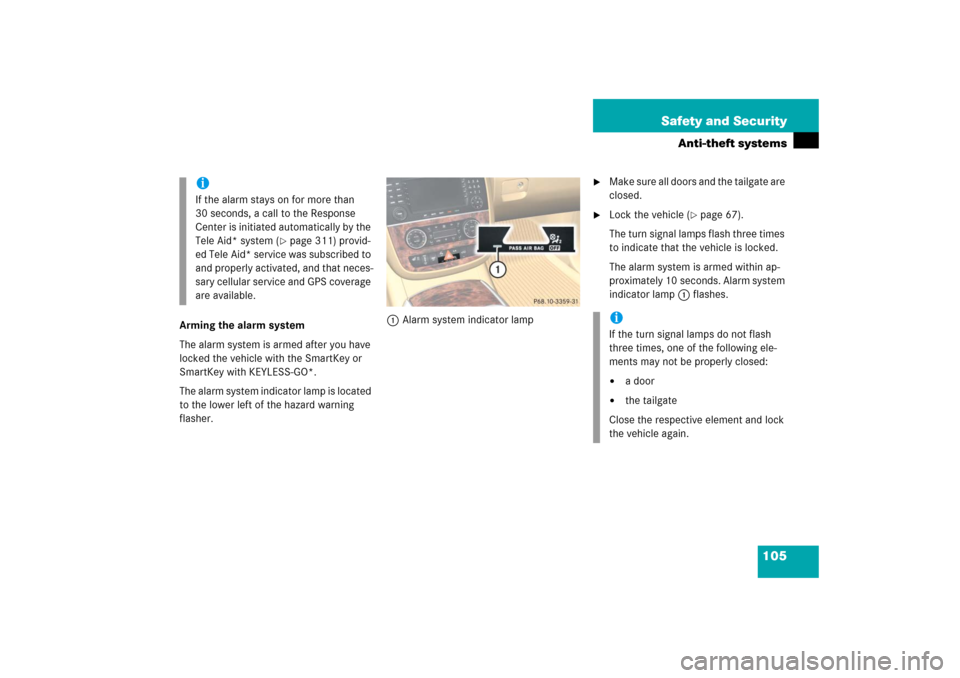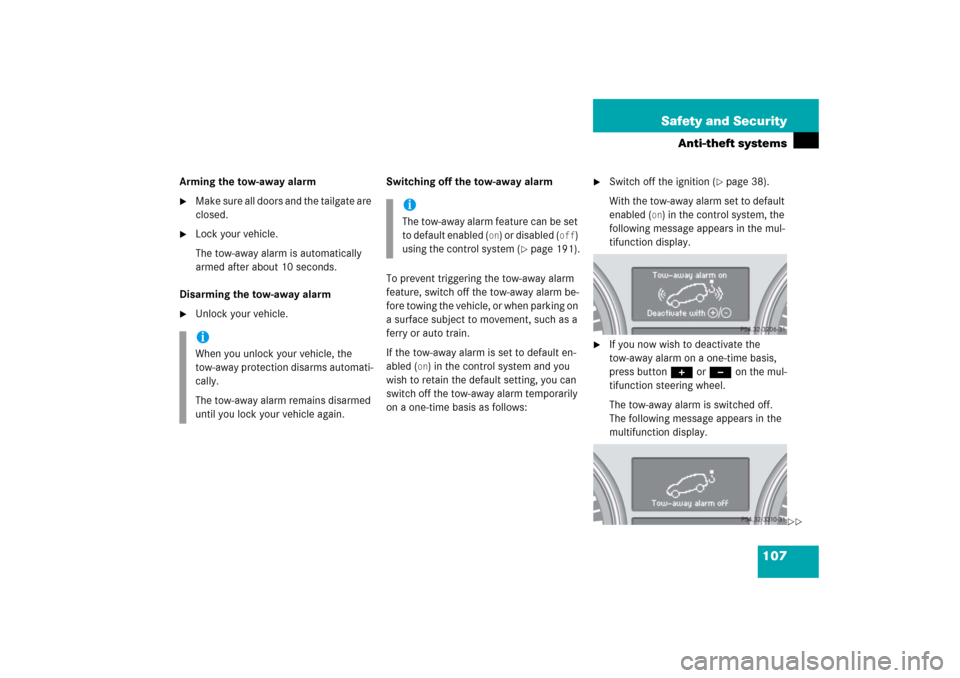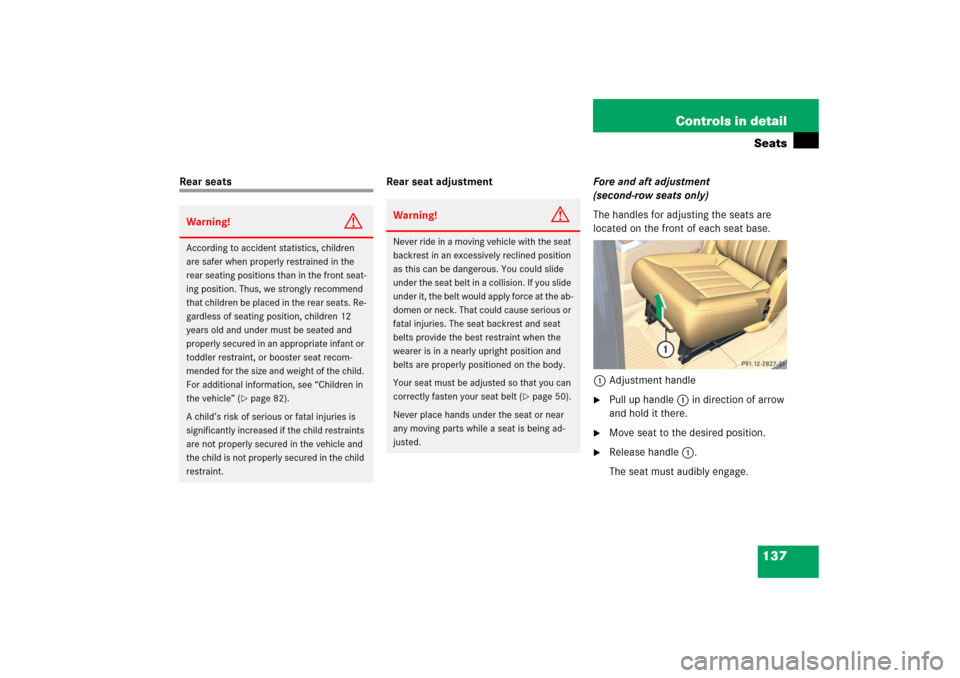Page 103 of 561

102 Safety and SecurityDriving safety systems
Switching on the ESP
®
�
Press ESP
® switch1.
The ESP
® warning lampv in the in-
strument cluster goes out.
You are now again in normal driving
mode with the ESP
® switched on.
For more information, see the “Practical
hints” section (
�page 404).
EBP
The EBP enhances braking effectiveness
by allowing the rear brakes to supply a
greater proportion of the braking effort
without a loss of vehicle stability.
4-ETS
The 4-Electronic Traction System (4-ETS)
improves the vehicle’s ability to utilize
available traction, especially under slip-
pery road conditions. The brakes are ap-
plied to the spinning wheel and power is
transferred to the wheel(s) with traction.
The ESP
® warning lampvin the instru-
ment cluster starts to flash at any vehicle
speed, as soon as a tire loses traction and
the wheel begins to spin.
Warning!
G
When the ESP
® warning lampv is
illuminated continuously, the ESP
® is
switched off.
Adapt your speed and driving to the prevail-
ing road conditions and to the non-operating
status of the ESP
®.
!Avoid spinning of a drive wheel for an
extended period of time with the ESP
®
switched off. This may cause serious
damage to the drivetrain which is not
covered by the Mercedes-Benz Limited
Warranty.
Page 104 of 561

103 Safety and Security
Driving safety systems
For more information, see the “Practical
hints” section (
�page 404) and
(
�page 416).
Warning!
G
When you see the ESP
® warning lampv
flashing in the instrument cluster, then pro-
ceed as follows:
�
While driving off, apply as little throttle
as possible.
�
While driving, ease up on the accelera-
tor.
�
Adapt your speed and driving style to
the prevailing road conditions.
Failure to observe these guidelines could
cause the vehicle to skid.
The 4-ETS cannot prevent accidents resul-
ting from excessive speed.
!Because of the ESP’s
® automatic oper-
ation, the engine must be shut off
(SmartKey in starter switch position0
or1) when the parking brake is being
tested on a brake test dynamometer.
Active braking action through ESP
®
may otherwise seriously damage the
brake system.
Operational tests with the engine
running can only be conducted on a
two-axle dynamometer.
iIf the yellow ESP
® warning lampv
comes on while driving, the 4-ETS is be-
ing switched off temporarily to prevent
overheating of the drive wheel brakes.
In addition, the message
ESP unavail-
able See Operator’s Manual
appears
in the multifunction display.
Page 105 of 561

104 Safety and SecurityAnti-theft systemsImmobilizer
The immobilizer prevents unauthorized
persons from starting your vehicle.
Activating
With the SmartKey�
Remove the SmartKey from the starter
switch.
With KEYLESS-GO*
�
Press the KEYLESS-GO start / stop
button (
�page 40) once.
The engine is turned off.
�
Open the driver’s door.Deactivating
With the SmartKey
�
Turn the SmartKey in the starter switch
to position2 (
�page 38).
With KEYLESS-GO*
�
Switch on the ignition (
�page 38).
Anti-theft alarm system
Once the alarm system has been armed, a
visual and audible alarm is triggered when
someone opens�
a door
�
the tailgate
�
the hood
The alarm will stay on, even if the activat-
ing element (a door, for example) is imme-
diately closed.
The alarm system will also be triggered
when
�
the vehicle is raised, see “Tow-away
alarm” (
�page 106)
�
the vehicle is opened with the mechan-
ical key, see “Unlocking the vehicle”
(�page 459)
�
a door is opened from the inside, see
“Opening the doors from the inside”
(�page 121)
iStarting the engine will also deactivate
the immobilizer.
In case the engine cannot be started
(yet the vehicle’s battery is charged),
the system is not operational. Contact
an authorized Mercedes-Benz Light
Truck Center or call
1-800-FOR-MERCedes (in the USA), or
1-800-387-0100 (in Canada).
Page 106 of 561

105 Safety and Security
Anti-theft systems
Arming the alarm system
The alarm system is armed after you have
locked the vehicle with the SmartKey or
SmartKey with KEYLESS-GO*.
The alarm system indicator lamp is located
to the lower left of the hazard warning
flasher.1Alarm system indicator lamp
�
Make sure all doors and the tailgate are
closed.
�
Lock the vehicle (
�page 67).
The turn signal lamps flash three times
to indicate that the vehicle is locked.
The alarm system is armed within ap-
proximately 10 seconds. Alarm system
indicator lamp 1 flashes.
iIf the alarm stays on for more than
30 seconds, a call to the Response
Center is initiated automatically by the
Tele Aid* system (
�page 311) provid-
ed Tele Aid* service was subscribed to
and properly activated, and that neces-
sary cellular service and GPS coverage
are available.
iIf the turn signal lamps do not flash
three times, one of the following ele-
ments may not be properly closed:�
a door
�
the tailgate
Close the respective element and lock
the vehicle again.
Page 107 of 561

106 Safety and SecurityAnti-theft systemsDisarming the alarm system�
Unlock the vehicle (
�page 36).
The turn signal lamps flash once to
indicate that the vehicle is disarmed.Canceling the alarm
To cancel the alarm:
With the SmartKey
�
Insert the SmartKey in the starter
switch.
or
�
Press theŒ or ‹button on the
SmartKey.
With KEYLESS-GO*
�
Grasp an outside door handle.
The SmartKey with KEYLESS-GO must
be within 3 ft (1 m) of the vehicle.
or
�
Press the KEYLESS-GO start / stop
button (
�page 40).
The SmartKey with KEYLESS-GO must
be inside the vehicle.
Tow-away alarm
Once the tow-away alarm is armed, a visual
and audible alarm will be triggered when
someone attempts to raise the vehicle.
iThe alarm system will rearm automati-
cally again after approximately
40 seconds if neither a door nor the
tailgate is opened.
iThe tow-away protection alarm is trig-
gered, for example, if the vehicle is
lifted on one side.
If the alarm stays on for more than
30 seconds, a call to the Response
Center is initiated automatically by the
Tele Aid* system (
�page 311) provid-
ed Tele Aid* service was subscribed to
and properly activated, and that neces-
sary cellular service and GPS coverage
are available.
Page 108 of 561

107 Safety and Security
Anti-theft systems
Arming the tow-away alarm�
Make sure all doors and the tailgate are
closed.
�
Lock your vehicle.
The tow-away alarm is automatically
armed after about 10 seconds.
Disarming the tow-away alarm
�
Unlock your vehicle.Switching off the tow-away alarm
To prevent triggering the tow-away alarm
feature, switch off the tow-away alarm be-
fore towing the vehicle, or when parking on
a surface subject to movement, such as a
ferry or auto train.
If the tow-away alarm is set to default en-
abled (
on) in the control system and you
wish to retain the default setting, you can
switch off the tow-away alarm temporarily
on a one-time basis as follows:
�
Switch off the ignition (
�page 38).
With the tow-away alarm set to default
enabled (
on) in the control system, the
following message appears in the mul-
tifunction display.
�
If you now wish to deactivate the
tow-away alarm on a one-time basis,
press button + or - on the mul-
tifunction steering wheel.
The tow-away alarm is switched off.
The following message appears in the
multifunction display.
iWhen you unlock your vehicle, the
tow-away protection disarms automati-
cally.
The tow-away alarm remains disarmed
until you lock your vehicle again.
iThe tow-away alarm feature can be set
to default enabled (
on) or disabled (
off
)
using the control system (
�page 191).
��
Page 109 of 561
108 Safety and SecurityAnti-theft systems�
Exit and lock the vehicle (
�page 67).
The alarm system is armed indepen-
dently of whether the tow-alarm is
switched on or off.Canceling tow-away alarm
To cancel the alarm after it has been
triggered:
With the SmartKey
�
Insert the SmartKey in the starter
switch.
or
�
Press theŒ or ‹button on the
SmartKey.With KEYLESS-GO*
�
Grasp an outside door handle.
The SmartKey with KEYLESS-GO must
be within 3 ft (1 m) of the vehicle.
or
�
Press the KEYLESS-GO start/stop
button (
�page 40).
The SmartKey with KEYLESS-GO must
be inside the vehicle.
iThe tow-away alarm is switched off on
a one-time basis only. It will be armed
automatically the next time you lock
the vehicle.
If you have disabled the tow-away
alarm feature in the control system
(�page 191), you can switch on the
tow-away alarm on a one-time basis as
described above.
��
Page 138 of 561

137 Controls in detailSeats
Rear seats Rear seat adjustmentFore and aft adjustment
(second-row seats only)
The handles for adjusting the seats are
located on the front of each seat base.
1Adjustment handle
�
Pull up handle 1 in direction of arrow
and hold it there.
�
Move seat to the desired position.
�
Release handle 1.
The seat must audibly engage.
Warning!
G
According to accident statistics, children
are safer when properly restrained in the
rear seating positions than in the front seat-
ing position. Thus, we strongly recommend
that children be placed in the rear seats. Re-
gardless of seating position, children 12
years old and under must be seated and
properly secured in an appropriate infant or
toddler restraint, or booster seat recom-
mended for the size and weight of the child.
For additional information, see “Children in
the vehicle” (
�page 82).
A child’s risk of serious or fatal injuries is
significantly increased if the child restraints
are not properly secured in the vehicle and
the child is not properly secured in the child
restraint.
Warning!
G
Never ride in a moving vehicle with the seat
backrest in an excessively reclined position
as this can be dangerous. You could slide
under the seat belt in a collision. If you slide
under it, the belt would apply force at the ab-
domen or neck. That could cause serious or
fatal injuries. The seat backrest and seat
belts provide the best restraint when the
wearer is in a nearly upright position and
belts are properly positioned on the body.
Your seat must be adjusted so that you can
correctly fasten your seat belt (
�page 50).
Never place hands under the seat or near
any moving parts while a seat is being ad-
justed.